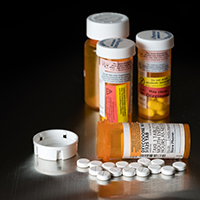 Oxycodone and hydrocodone are two of America’s most widely prescribed opioid pain medications. They are known for their potential to trigger addiction and rank among the nation’s most abused opioids. Although members of the same medication family, oxycodone and hydrocodone have different uses, and doctors prescribe each of them for certain types of pain.
Oxycodone and hydrocodone are two of America’s most widely prescribed opioid pain medications. They are known for their potential to trigger addiction and rank among the nation’s most abused opioids. Although members of the same medication family, oxycodone and hydrocodone have different uses, and doctors prescribe each of them for certain types of pain.
How Do Doctors Use Oxycodone?
Oxycodone[i] is perhaps best known as the sole active ingredient in a powerful painkiller called OxyContin. The medication also serves as the main ingredient in several other common prescription pain relievers, including Percocet, Oxycet and Percodan. All these medications combine the opioid with either aspirin or acetaminophen.
Doctors prescribe oxycodone-containing medications to people affected by moderate or severe forms of pain. They also have the option of prescribing an extended-release version of the opioid to any person who:
- Needs 24/7 treatment for their pain symptoms
- Requires this around-the-clock relief for extended amounts of time
- Has no other effective option for managing pain
Extended-release oxycodone is reserved for use in people who have already taken an opioid medication and have some tolerance to the effects of drugs in this class.
How Do Doctors Use Hydrocodone?
Hydrocodone[ii] is the active ingredient in the widely prescribed painkiller Vicodin. This brand-name medication also contains acetaminophen. Other branded medications that combine hydrocodone and acetaminophen include Lorcet and Lortab. Two extended-release options, Hysingla and Zohydro, only contain hydrocodone.
Doctors prescribe Vicodin and other hydrocodone/acetaminophen medications to people affected by severe pain, but not to people dealing with moderate pain. There are also important secondary criteria for hydrocodone use. First, a person must have symptoms that require 24/7 treatment. In addition, these symptoms must not be treatable with other, less powerful options. Both restrictions also apply to the extended-release products that only contain hydrocodone.
Which Option Is Better for Pain?
Hydrocodone and oxycodone are similar in many respects, and the two medications can provide equal benefits for people dealing with chronic, severe pain. Doctors may have a personal preference for one of these opioids and make their prescriptions based on this preference. They may also take secondary considerations into account.
For example, some people are allergic to hydrocodone or oxycodone, and must avoid use of that specific medication. In addition, the risks for side effects can differ between the two opioids. In a 2016 study published in the journal American Family Physician, researchers found that people who take a combination of oxycodone and acetaminophen have higher chances of experiencing dizziness and nausea than people who take a combination of hydrocodone and acetaminophen[iii].
Need More Information?
Call now to be connected with one of our friendly, helpful admissions specialists.Oxycodone Side Effects
People who take oxycodone (by itself or in combination with a non-opioid painkiller) can develop a range of relatively minor side effects. Potential problems include unusual sleepiness, headaches, unusual mood changes, facial redness (i.e., flushing), pain in the stomach or abdominal region and loss of mouth moisture.
Oxycodone use can also lead to more serious side effects that require rapid medical attention. Examples of these more dangerous problems include skin rash or itching, breathing difficulties, swallowing difficulties, intense sleepiness and an altered heartbeat (either slower or faster than normal). The list of potential issues also includes things such as visual or audio hallucinations, nausea with or without vomiting, dizziness, chest pain and swelling centered in the facial region or the upper or lower extremities. In addition, men may experience impotence, while women may experience altered menstruation.
Hydrocodone Side Effects
Hydrocodone use also comes with a risk for relatively minor side effects. Potential effects include unusual fatigue, headaches, ear ringing, insomnia, stomach or abdominal pain, swelling in the lower extremities, localized muscle tremors, back pain and pain while urinating or other changes in normal urination. People who take hydrocodone can also develop severe side effects that call for prompt medical care. The list of these effects is identical with the list of severe problems associated with oxycodone use.
Oxycodone, Hydrocodone and Opioid Dependence and Addiction
As strong opioid substances, both oxycodone and hydrocodone are capable of producing a condition called opioid dependence[iv]. This condition occurs when the brain grows used to the presence of oxycodone or hydrocodone and expects to receive a certain amount of the medication to support “normal” function.
Excessive use of hydrocodone or oxycodone can also lead to the onset of opioid addiction. In the case of opioid painkillers, addiction differs from dependence. Dependence is a manageable condition that occurs often among people who take either of the medications for long periods of time according to their doctors’ instructions. Doctors look for signs of this issue and provide the oversight required to stop dependence from transitioning into full-blown addiction.
People affected by opioid addiction have lost control of their medication intake and take hydrocodone or oxycodone more often and/or in larger amounts than a reputable doctor would prescribe. Other hallmarks of addiction include rising tolerance to the painkilling or mind-altering effects of opioid use and the development of withdrawal symptoms when the brain doesn’t receive its expected amount of opioids
People dependent on opioids will also develop withdrawal symptoms if their intake ceases or drops rapidly. However, doctors can manage medication use in ways that minimize symptom severity.
Withdrawal Symptoms
Withdrawal symptoms are the same for people who use hydrocodone, oxycodone or any other opioid drugs or medications[v]. Problems that occur in the early stages of the process include aching muscles, unusual or uncontrolled yawning, sleeplessness, increased sweat and tear output, increased mucus production and an agitated or anxious state of mind. Other symptoms that can appear as withdrawal runs its course include nausea (sometimes followed by vomiting), diarrhea, unusually wide or dilated pupils, stomach or abdominal cramps and goose bumps.
Treatment for Oxycodone or Hydrocodone Addiction
There are proven treatment options for people dealing with any form of opioid addiction[vi]. Medications used for this purpose include: the weak opioid buprenorphine; the stronger opioid methadone; the anti-opioid naloxone; and the anti-opioid naltrexone.
Buprenorphine can serve as a safer, short-term or long-term substitute for hydrocodone or oxycodone. Methadone is typically used as a long-term substitute. Naloxone and naltrexone provide their benefits by stopping opioids from reaching the brain. However, doctors reserve the use of naltrexone for people who have completely detoxed from opioids.
Experts strongly recommend that people in treatment for opioid addiction also receive some form of behavioral psychotherapy. Potential options here include[vii]:
- 12-step facilitation therapy
- Contingency management
- Community reinforcement approach (CRA) plus vouchers
The combined use of maintenance medications, counseling and behavioral therapy for people with substance use disorders is known as medication-assisted treatment, or MAT. Transformations Treatment Center uses Suboxone, which contains both naloxone and buprenorphine, in our medication-assisted treatment program.
- U.S. National Library of Medicine – MedlinePlus: Oxycodone
https://medlineplus.gov/druginfo/meds/a682132.html - U.S. National Library of Medicine – MedlinePlus: Hydrocodone
https://medlineplus.gov/druginfo/meds/a614045.html - American Family Physician: No Difference Between Oxycodone/Acetaminophen and Hydrocodone/Acetaminophen for Acute Extremity Pain
https://www.aafp.org/afp/2016/0301/p411.html - The National Alliance of Advocates for Buprenorphine Treatment: Physical Dependence and Addiction – An Important Distinction
http://www.naabt.org/addiction_physical-dependence.cfm - U.S. National Library of Medicine – MedlinePlus: Opiate and Opioid Withdrawal
https://medlineplus.gov/ency/article/000949.htm - National Institute on Drug Abuse: Effective Treatments for Opioid Addiction
https://www.drugabuse.gov/publications/effective-treatments-opioid-addiction/effective-treatments-opioid-addiction - National Institute on Drug Abuse: Principles of Drug Addiction Treatment – A Research-Based Guide (Third Edition)
https://www.drugabuse.gov/sites/default/files/podat_1.pdf




